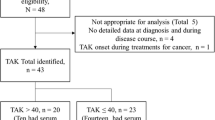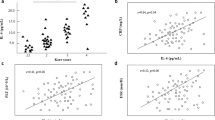Abstract
The aim of the study was to explore utility of serial serum myeloid-related protein 8/14 (MRP8/14) as a biomarker of clinical disease activity and angiographic progression in Takayasu arteritis (TA). Serum MRP8/14 levels were assayed by commercial ELISA for 85 TA patients and 24 healthy controls at baseline, and for 56 and 21 TA patients during follow-up visits R1 and R2, respectively. Disease was categorised as active, indeterminate and stable according to Indian Takayasu Arteritis score (ITAS 2010), ITAS-A(CRP) and angiography. Patients were divided into responders and non-responders/relapsers based on treatment response. Non-parametric tests were used for inter-group comparisons at baseline and during follow-up time points. Generalised Estimating Equation was used to study association between changes in serial MRP8/14 levels and disease activity. At baseline, median MRP8/14 levels were higher in patients with TA than healthy controls [7353 (4524 to11283) vs 4896 (3194 to 8474.5) ng/ml, p = 0.011]. Patients with active disease had higher levels [8552 (5463–12488)] than stable disease [5292.5 (3140.5–7310)], p = 0.002, and healthy controls [4896 (3194–8474.5)], p = 0.001. Changes in serial MRP8/14 level were associated with changes in disease activity, independent of steroid dose, p = 0.000. At R1, MRP 8/14 levels were lower than baseline in responders (n = 38) [9146.0 (6296.8–13693.8) vs 6501 (4314.8–8304.5), p = 0.004], but did not change in non-responders/relapsers (n = 14) [6693.5(4210.8–10516.3) vs 7755.0(5342–10741.0), p = 0.42]. Similar trend was observed at R2. MRP8/14 levels increased during follow-up in 66% and 26.3% of angiographic progressors and non-progressors, respectively. MRP8/14 in TA may act as a novel biomarker with prognostic implications.




Similar content being viewed by others
References
Kerr GS, Hallahan CW, Giordano J, Leavitt RY, Fauci AS, Rottem M et al (1994) Takayasu Arteritis. Ann Intern Med;120(11):919–929
Foell D, Wittkowski H, Vogl T, Roth J. S100 proteins expressed in phagocytes: a novel group of damage-associated molecular pattern molecules. J Leukoc Biol 2007;81(1):28–37
Foell D, Frosch M, Sorg C, Roth J (2004) Phagocyte-specific calcium-binding S100 proteins as clinical laboratory markers of inflammation. Clin Chim Acta Int J Clin Chem 344(1–2):37–51
Nacken W, Roth J, Sorg C, Kerkhoff C. S100A9/S100A8: Myeloid representatives of the S100 protein family as prominent players in innate immunity. Microsc Res Tech 2003 15;60(6):569–580
Hogg N, Allen C, Edgeworth J (1989) Monoclonal antibody 5.5 reacts with p8,14, a myeloid molecule associated with some vascular endothelium. Eur J Immunol 19(6):1053–1061
Srikrishna G, Panneerselvam K, Westphal V, Abraham V, Varki A, Freeze HH (1950) Two proteins modulating transendothelial migration of leukocytes recognize novel carboxylated glycans on endothelial cells. J Immunol Baltim Md 1950 2001;166(7):4678–4688
Viemann D, Strey A, Janning A, Jurk K, Klimmek K, Vogl T et al. Myeloid-related proteins 8 and 14 induce a specific inflammatory response in human microvascular endothelial cells. Blood 2005;105(7):2955–2962
Vogl T, Tenbrock K, Ludwig S, Leukert N, Ehrhardt C, van Zoelen MAD et al (2007) Mrp8 and Mrp14 are endogenous activators of Toll-like receptor 4, promoting lethal, endotoxin-induced shock. Nat Med 13(9):1042–1049
Youssef P, Roth J, Frosch M, Costello P, Fitzgerald O, Sorg C et al (1999) Expression of myeloid related proteins (MRP) 8 and 14 and the MRP8/14 heterodimer in rheumatoid arthritis synovial membrane. J Rheumatol 26(12):2523–2528
Kane D, Roth J, Frosch M, Vogl T, Bresnihan B, FitzGerald O (2003) Increased perivascular synovial membrane expression of myeloid-related proteins in psoriatic arthritis. Arthritis Rheum 48(6):1676–1685
Anink J, Van Suijlekom-Smit LWA, Otten MH, Prince FHM, van Rossum MAJ, Dolman KM et al. MRP8/14 serum levels as a predictor of response to starting and stopping anti-TNF treatment in juvenile idiopathic arthritis. Arthritis Res Ther 2015;17:200
Rahman MT, Myles A, Gaur P, Misra R, Aggarwal A (2014) TLR4 endogenous ligand MRP8/14 level in enthesitis-related arthritis and its association with disease activity and TLR4 expression. Rheumatol Oxf Engl 53(2):270–274
Foell D, Hernández-Rodríguez J, Sánchez M, Vogl T, Cid MC, Roth J (2004) Early recruitment of phagocytes contributes to the vascular inflammation of giant cell arteritis. J Pathol 204(3):311–316
Arend WP, Michel BA, Bloch DA, Hunder GG, Calabrese LH, Edworthy SM et al (1990) The American College of Rheumatology 1990 criteria for the classification of Takayasu arteritis. Arthritis Rheum 33(8):1129–1134
Goel R, Kabeerdoss J, Mohan H, Danda S, Jayaseelan V, Kumar TS et al. Soluble-HLA-E: A follow up biomarker in Takayasu arteritis, independent of HLA-E genotype. Int J Rheum Dis. 2017 19
Pryshchep O, Ma-Krupa W, Younge BR, Goronzy JJ, Weyand CM. Vessel-specific toll-like receptor profiles in human medium and large arteries. Circulation 2008 16;118(12):1276–1284
Author information
Authors and Affiliations
Contributions
RG has contributed to designing and execution of the study. RG, AN, JK, GJ and DD have contributed to preparation and critical review of manuscript. HM has assisted in MRP 8/14 ELISA and VJ has helped in statistical analysis.
Corresponding author
Ethics declarations
The authors have no potential conflicts of interest. All procedures performed in this study were in accordance with the ethical standards of institutional research committee and complied with the 1994 Helsinki Declaration and its amendments or comparable ethical standards. The patients were recruited in this study after written informed consent.
Funding
This study was supported by a research grant to Dr. Aswin Nair from the Indian Rheumatology Association.
Electronic supplementary material
Below is the link to the electronic supplementary material.
Rights and permissions
About this article
Cite this article
Goel, R., Nair, A., Kabeerdoss, J. et al. Study of serial serum myeloid-related protein 8/14 as a sensitive biomarker in Takayasu arteritis: a single centre study. Rheumatol Int 38, 623–630 (2018). https://doi.org/10.1007/s00296-017-3881-4
Received:
Accepted:
Published:
Issue Date:
DOI: https://doi.org/10.1007/s00296-017-3881-4




